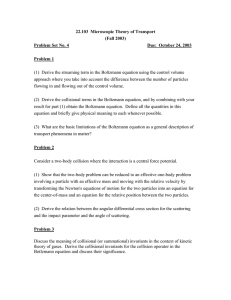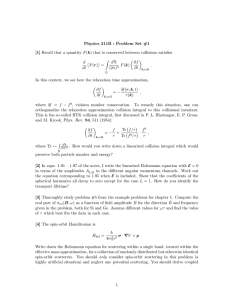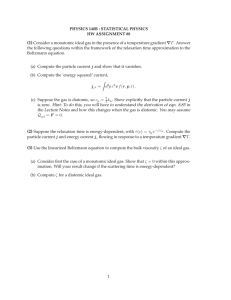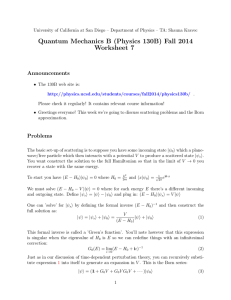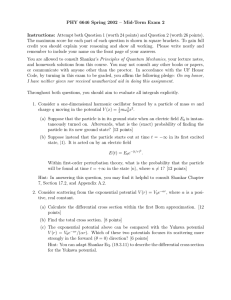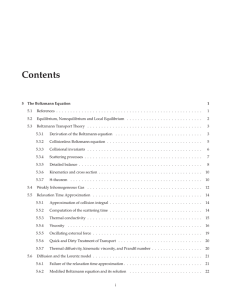8 Nonequilibrium and Transport Phenomena : Summary
advertisement
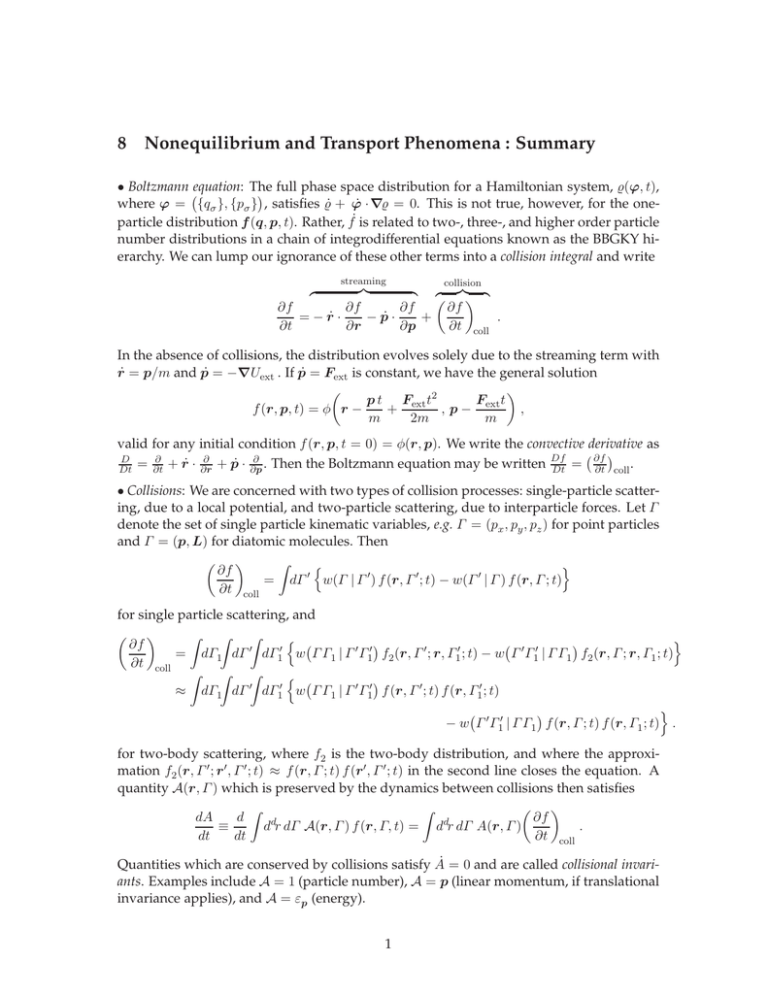
8 Nonequilibrium and Transport Phenomena : Summary
• Boltzmann equation: The
full phase space distribution for a Hamiltonian system, ̺(ϕ, t),
where ϕ = {qσ }, {pσ } , satisfies ̺˙ + ϕ̇ ·∇̺ = 0. This is not true, however, for the oneparticle distribution f (q, p, t). Rather, f˙ is related to two-, three-, and higher order particle
number distributions in a chain of integrodifferential equations known as the BBGKY hierarchy. We can lump our ignorance of these other terms into a collision integral and write
streaming
collision
}|
{ z }| {
∂f
∂f
∂f
∂f
= − ṙ ·
− ṗ ·
+
.
∂t
∂r
∂p
∂t coll
z
In the absence of collisions, the distribution evolves solely due to the streaming term with
ṙ = p/m and ṗ = −∇Uext . If ṗ = Fext is constant, we have the general solution
p t Fext t2
Fext t
f (r, p, t) = φ r −
+
, p−
,
m
2m
m
valid for any initial condition f (r, p, t = 0) = φ(r, p). We write the convective derivative as
∂f Df
∂
∂
∂
D
Dt = ∂t + ṙ · ∂r + ṗ · ∂p . Then the Boltzmann equation may be written Dt = ∂t coll .
• Collisions: We are concerned with two types of collision processes: single-particle scattering, due to a local potential, and two-particle scattering, due to interparticle forces. Let Γ
denote the set of single particle kinematic variables, e.g. Γ = (px , py , pz ) for point particles
and Γ = (p, L) for diatomic molecules. Then
Z
n
o
∂f
= dΓ ′ w(Γ | Γ ′ ) f (r, Γ ′ ; t) − w(Γ ′ | Γ ) f (r, Γ ; t)
∂t coll
for single particle scattering, and
Z
Z
Z
n
o
∂f
′
= dΓ1 dΓ dΓ1′ w Γ Γ1 | Γ ′ Γ1′ f2 (r, Γ ′ ; r, Γ1′ ; t) − w Γ ′ Γ1′ | Γ Γ1 f2 (r, Γ ; r, Γ1 ; t)
∂t coll
Z
Z
Z
n
′
≈ dΓ1 dΓ dΓ1′ w Γ Γ1 | Γ ′ Γ1′ f (r, Γ ′ ; t) f (r, Γ1′ ; t)
o
′ ′
− w Γ Γ1 | Γ Γ1 f (r, Γ ; t) f (r, Γ1 ; t) .
for two-body scattering, where f2 is the two-body distribution, and where the approximation f2 (r, Γ ′ ; r ′ , Γ ′ ; t) ≈ f (r, Γ ; t) f (r ′ , Γ ′ ; t) in the second line closes the equation. A
quantity A(r, Γ ) which is preserved by the dynamics between collisions then satisfies
Z
Z
d
∂f
dA
d
d
≡
d r dΓ A(r, Γ ) f (r, Γ, t) = d r dΓ A(r, Γ )
.
dt
dt
∂t coll
Quantities which are conserved by collisions satisfy Ȧ = 0 and are called collisional invariants. Examples include A = 1 (particle number), A = p (linear momentum, if translational
invariance applies), and A = εp (energy).
1
• Time reversal, parity, and detailed balance: With Γ = (p, L), we define the actions of time
reversal and parity as
Γ T = (−p, −L)
,
Γ P = (−p, L)
,
Γ C = (p, −L) ,
where C = P T is the combined operation.
of the underlying
Time reversal symmetry
equations of motion requires w Γ ′ Γ1′ | Γ Γ1 = w Γ T Γ1T | Γ ′ T Γ1′ T . Under conditions of detailed balance, this leads to f 0 (Γ ) f 0 (Γ1 ) = f 0 (Γ ′ T ) f 0 (Γ1′ T ), where f 0is the equilibrium dis
tribution. For systems with both P and T symmetries, w Γ ′ Γ1′ | Γ Γ1 = w Γ C Γ1C | Γ ′ C Γ1′ C ,
whence w(p′ , p′1 | p, p1 ) = w(p, p1 | p′ , p′1 ) for point particles.
R
• Boltzmann’s H-theorem: Let h(r, t) = dΓ f (r, Γ, t) ln f (r, Γ, t). Invoking the
R Boltzmann
dH
equation, it can be shown that ∂h
≤
0,
which
means
≤
0,
where
H(t)
=
ddr h(r, t) is
∂t
dt
Boltzmann’s H-function. h(r, t) is everywhere decreasing or constant, due to collisions.
• Weakly inhomogeneous gas: Under equilibrium conditions, f 0 can be a function only of
collisional invariants, and takes the Gibbs form f 0 (r, p) = Ce(µ+V·p−εΓ )/kB T . Assume now
that µ, V , and T are all weakly dependent on r and t. f 0 then describes a local equilibrium
and as such is annihilated by the collision term in the Boltzmann equation, but not by the
streaming term. Accordingly, we seek a solution f = f 0 + δf . A lengthy derivation results
in
)
(
εΓ − h + T cp
εΓ − h
∂f
∂ δf
f0
ext
v · ∇T + m vα vβ Qαβ −
+
=
∇·V − F · v
,
T
cV /kB
kB T
∂t
∂t coll
where v =
∂ε
∂p
is the particle velocity, h is the enthalpy per particle, Qαβ =
1
2
∂V α
∂xβ
+
∂V β
∂xα
,
and F ext is an external force. For an ideal gas, h = cp T . The RHS is to be evaluated to first
order in δf . The simplest model for the collision integral is the relaxation time approximation,
δf
where ∂f
∂t coll = − τ . Note that this form does not preserve any collisional invariants. The
scattering time is obtained from the relation nv̄rel στ = 1, where σ is the two particle total
scattering cross section and v̄rel is the average relative speed of a pair of particles. This
says that there is on average one collision within a tube
qof cross sectional area σ and length
√
16 kB T
−1/2 . The mean
v̄rel τ . For the Maxwellian distribution, v̄rel = 2 v̄ =
πm , so τ (T ) ∝ T
free path is defined as ℓ = v̄τ = √21nσ .
• Transport coefficients: Assuming Fαext = Qαβ = 0 and steady state, Eq. 8 yields
δf = −
τ (ε − cp T )
(v ·∇T ) f 0 .
kB T 2
The energy current is given by
thermal conductivity καβ
jεα =
Z
}|
{
nτ
∂T
dΓ εΓ v α δf = −
v α v β εΓ (εΓ − cp T )
.
2
kB T
∂xβ
z
2
For a monatomic gas, one finds καβ = κ δαβ with κ(T ) = π8 nℓv̄cp ∝ T 1/2 . A similar result
follows by considering any intensive quantity φ which is spatially dependent through the
temperature T (r). The φ-current across the surface z = 0 is
Z
Z
∂φ
3
ẑ .
jφ = nẑ d v P (v) vz φ(z − ℓ cos θ) + nẑ d3v P (v) vz φ(z + ℓ cos θ) = − 13 n v̄ ℓ
∂z
vz >0
vz <0
Thus, jφ = −K∇T , with K = 13 n ℓ v̄
∂φ
∂T
the associated transport coefficient. If φ = hεΓ i,
∂Vx
x
then
= cp , yielding κ =
If φ = hpx i, then jpzx = Πxz = − 13 nmℓv̄ ∂V
∂z ≡ −η ∂z ,
where η is the shear viscosity. Using the Boltzmann equation in the relaxation time approximation, one obtains η = π8 nmℓv̄. From κ and η, we can form a dimensionless quantity Pr = ηcp /mκ, known as the Prandtl number. Within the relaxation time approximation,
Pr = 1. Most monatomic gases have Pr ≈ 23 .
∂φ
∂T
1
3 nℓv̄cp .
• Linearized Boltzmann equation: To go beyond the phenomenological relaxation time approximation, one must grapple with the collision integral,
∂f
∂t
coll
=
Z
Z
Z
n
o
d p1 d p d3p′1 w(p′ , p′1 | p, p1 ) f (p′ ) f (p′1 ) − f (p) f (p1 ) ,
3
3 ′
which is a nonlinear functional of the distribution f (p, t) (we suppress the t index here).
0
2
Writing f (p) = f 0 (p) + f 0 (p) ψ(p), we have ∂f
∂t coll = f (p) L̂ψ + O(ψ ), with
Z
Z
n
o
∂σ 0
3
f (p1 ) ψ(p′ ) + ψ(p′1 ) − ψ(p) − ψ(p1 ) .
L̂ψ(p) = d p1 dΩ |v − v1 |
∂Ω
∂
The linearized Boltzmann equation (LBE) then takes the form L̂ − ∂t
ψ = Y , where
(
)
ε(p) − 25 kB T
kB ε(p)
1
Y =
v · ∇T + m vα vβ Qαβ −
∇·V − F · v .
kB T
T
cV
∂
for point particles. To solve the LBE, we must invert the operator
R 3 L̂0 − ∂t . Various useful
properties follow from defining the inner product hψ1 |ψ2 i ≡ d p f (p) ψ1 (p) ψ2 (p), such
as the self-adjointness of L̂: hψ1 |L̂ψ2 i = hL̂ψ1 |ψ2 i. We then have L̂|φn i = −λn | φn i, with
hφm |φn i = δmn and real eigenvalues λn . There are five zero eigenvalues corresponding to
the collisional invariants:
r pα
2 ε(p) 3
1
√
p
−
.
,
φ2,3,4 (p) =
,
φ5 (p) =
φ1 (p) =
3n kB T
2
n
nmkB T
P
−λn t . Aside from
When Y = 0, the formal solution to ∂ψ
n Cn φn (p) e
∂t = L̂ψ is ψ(p, t) =
the collisional invariants, all the eigenvalues λn must be positive, corresponding to relaxation to the equilibrium state. One can check that the particle, energy, and heat currents
are given by j = h v | ψ i, jε = h v ε | ψ i, and jq = h v (ε − µ) | ψ i.
3
In steady state, the solution to L̂ψ = Y is ψ = L̂−1 Y . This is valid provided Y is orthogonal
to each of the collisional invariants, in which case
X
ψ(p) =
λ−1
n h φn | Y i φn (p) .
n∈CI
/
Once we have | ψ i, we may obtain the various transport coefficients by computing the
requisite currents. For example, to find the thermal conductivity κ and shear viscosity η,
κ
:
Y =
1 ∂T
X
kB T 2 ∂x κ
,
⇒
κ=−
h Xκ | ψ i
∂T /∂x
η
:
Y =
m ∂Vx
X
kB T ∂y η
Xκ ≡ ε − 52 kB vx
,
Xη ≡ vx vy
⇒
η=−
m h Xη | ψ i
.
∂Vx /∂y
2
• Variational approach: The Schwarz inequality, h ψ | − L̂ | ψ i · h φ | Ĥ | φ i ≥ h φ | Ĥ | ψ i ,
holds for the positive semidefinite operator Ĥ ≡ −L̂. One therefore has
1 h φ | Xκ i2
κ≥
kB T 2 h φ | Ĥ | φ i
,
2
m2 h φ | Xη i
η≥
.
kB T h φ | Ĥ | φ i
Using variational functions φκ = ε − 25 kB T vx and φη = vx vy , one finds, after tedious
calculations,
kB T 1/2
5 (mkB T )1/2
75 kB
√
√
.
,
η
≥
κ≥
64 π d2 m
16 π d2
Taking the lower limit in each case, we obtain a Prandtl number Pr =
close to what is observed for monatomic gases.
η cp
mκ
= 23 , which is
• Quantum transport: For quantum systems, the local equilibrium distribution is of the
Bose-Einstein or Fermi-Dirac form,
(
)−1
ε(k)
−
µ(r,
t)
f 0 (r, k, t) = exp
∓1
,
kB T (r, t)
with k = p/~, and
∂f
∂t
coll
=
Z
Z 3 ′Z 3 ′
n
o
dk
d k1
d3k1
′ ′
′
′
w
f
f
(1
±
f
)
(1
±
f
)
−
f
f
(1
±
f
)
(1
±
f
)
1
1
1
1
(2π)3 (2π)3 (2π)3
where w = w(k, k1 | k′ , k1′ ), f = f (k), f1 = f (k1 ), f ′ = f (k′ ), and f1′ = f (k1′ ), and where
we have assumed time-reversal and parity symmetry. The most important application is to
electron transport in metals and semiconductors, in which case f 0 is the Fermi distribution.
With f = f 0 + δf , one has, within the relaxation time approximation,
0
∂f
e
∂ δf
ε−µ
δf
∂ δf
−
v×B·
− v · eE+
∇T
=− ,
∂t
~c
∂k
T
∂ε
τ
4
where E = −∇(φ − µ/e) = E − e−1 ∇µ is the gradient of the ‘electrochemical potential’
φ − e−1 µ. For steady state transport with B = 0, one has
Z 3
dk
v δf ≡ L11 E − L12 ∇ T
j = −2e
(2π)3
Ω̂
Z 3
dk
jq = 2
(ε − µ) v δf ≡ L21 E − L22 ∇ T
(2π)3
Ω̂
αβ
αβ
αβ
αβ
2 αβ
where Lαβ
11 = e J0 , L21 = T L12 = −e J1 , and L22 =
Jnαβ
1
≡ 3
4π ~
Z
n
dε τ (ε) (ε − µ)
∂f 0
−
∂ε
1
T
J2αβ , with
Z
dSε
vα vβ
.
|v|
These results entail
E= ρj + Q∇T
,
jq = ⊓ j − κ ∇ T ,
or, in terms of the Jn ,
ρ=
1 −1
J
e2 0
,
Q=−
1
J −1 J1
eT 0
,
1
⊓ = − J1 J0−1
e
,
κ=
These results describe the following physical phenomena:
1
J2 − J1 J0−1 J1 .
T
Electrical resistance (∇T = B = 0): An electrical current j will generate an electric field
E = ρj, where ρ is the electrical resistivity.
Peltier effect (∇T = B = 0): An electrical current j will generate an heat current jq = ⊓j,
where ⊓ is the Peltier coefficient.
Thermal conduction (j = B = 0): A temperature gradient ∇T gives rise to a heat current
jq = −κ∇T , where κ is the thermal conductivity.
Seebeck effect (j = B = 0): A temperature gradient ∇T gives rise to an electric field
E = Q∇T , where Q is the Seebeck coefficient.
For a parabolic band with effective electron mass m∗ , one finds
ρ=
m∗
ne2 τ
,
Q=−
π 2 kB2 T
2e εF
,
κ=
π 2 nτ kB2 T
3m∗
2
with ⊓ = T Q, where εF is the Fermi energy. The ratio κ/σT = π3 (kB /e)2 = 2.45 ×
10−8 V2 K−2 is then predicted to be universal, a result known as the Wiedemann-Franz law.
This also predicts all metals to have negative thermopower, which is not the case. In the
presence of an external magnetic field B, additional transport effects arise:
Hall effect ( ∂T
∂x =
∂T
∂y
= jy = 0): An electrical current j = jx x̂ and a field B = Bz ẑ yield
an electric field E. The Hall coefficient is RH = Ey /jx Bz .
5
Ettingshausen effect ( ∂T
∂x = jy = jq,y = 0): An electrical current j = jx x̂ and a field
∂T
B = Bz ẑ yield a temperature gradient ∂T
∂y . The Ettingshausen coefficient is P = ∂y jx Bz .
Nernst effect (jx = jy =
∂T
∂y
= 0): A temperature gradient ∇ T =
yield an electric field E. The Nernst coefficient is Λ = Ey ∂T
∂x Bz .
∂T
∂x
x̂ and a field B = Bz ẑ
Righi-Leduc effect (jx = jy = Ey = 0): A temperature gradient ∇ T =
B = Bz ẑ yield an orthogonal gradient
∂T
∂y .
∂T
∂x
x̂ and a field
∂T
The Righi-Leduc coefficient is L =
∂x Bz .
∂T
∂y
• Stochastic processes: Stochastic processes involve a random element, hence they are not
wholly deterministic. The simplest example is the Langevin equation for Brownian motion, ṗ + γp = F + η(t), where p is a particle’s momentum, γ a damping rate due to friction,
F an external force, and η(t) a stochastic random force. We can integrate this first order
equation to obtain
F
1 − e−γt +
p(t) = p(0) e−γt +
γ
Zt
ds η(s) eγ(s−t) .
0
We assume that the random force η(t) has zero mean, and furthermore that
η(s) η(s′ ) = φ(s − s′ ) ≈ Γ δ(s − s′ ) ,
in which case one finds hp2 (t)i = hp(t)i2 +
Γ
2γ (1
− e−2γt ). If there is no external force, we
2
p
i = 12 kB T . This fixes Γ = 2γmkB T ,
expect the particle thermailzes at long times, i.e. h 2m
where m is the particle’s mass. One can integrate again to find the position. At late times
Ft
, corresponding to a mean velocity hp/mi = F/γ.
t ≫ γ −1 , one finds hx(t)i = const. + γm
The RMS fluctuations in position, however, grow as
hx2 (t)i − hx(t)i2 =
2kB T t
≡ 2Dt ,
γm
where D = kB T /γm is the diffusion constant. Thus, after the memory of the initial conditions is lost (t ≫ γ −1 ), the mean position advances linearly in time due to the external
force, and the RMS fluctuations in position also increase linearly.
• Fokker-Planck equation: Suppose x(t) is a stochastic variable, and define
δx(t) ≡ x(t + δt) − x(t) .
n −
[δx(t)]
Furthermore, assume hδx(t)i = F1 x(t) δt and [δx(t)]2 = F2 x(t) δt, but that
O(δt2 ) for n > 2. One can then show that the probability density P (x, t) = δ x − x(t)
satisfies the Fokker-Planck equation,
1 ∂2 ∂P
∂ F2 (x) P (x, t) .
=−
F1 (x) P (x, t) +
2
∂t
∂x
2 ∂x
6
For Brownian motion, F1 (x) = F/γm ≡ u and F2 (x) = 2D. The resulting Fokker-Planck
∂ 2P
equation is then Pt = −uPx + DPxx , where Pt = ∂P
∂t , Pxx = ∂x2 , etc. The Galilean transformation x → x − ut then results in Pt = DPxx , which is known as the diffusion equation,
R∞
a general solution to which is given by P (x, t) = dx′ K(x − x′ , t − t′ ) P (x′ , t′ ), where
−∞
2 /4D∆t
K(∆x, ∆t) = (4πD∆t)−1/2 e−(∆x)
√
is the diffusion kernel. Thus, ∆xRMS = 2D∆t.
7
